
The Sipuncula or Sipunculida is a class containing about 162 species of unsegmented marine annelid worms. Sipuncula was once considered a phylum, but was demoted to a class of Annelida, based on recent molecular work.
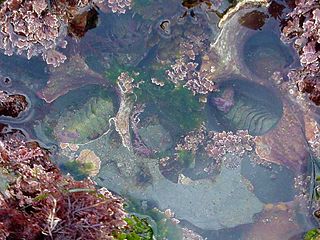
Benthos, also known as benthon, is the community of organisms that live on, in, or near the bottom of a sea, river, lake, or stream, also known as the benthic zone. This community lives in or near marine or freshwater sedimentary environments, from tidal pools along the foreshore, out to the continental shelf, and then down to the abyssal depths.
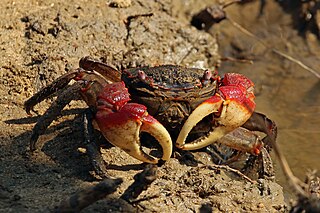
Mangrove crabs are crabs that live in and around mangroves. They belong to many different species and families and have been shown to be ecologically significant by burying and consuming leaf litter. Mangrove crabs have a variety of phylogenies because mangrove crab is an umbrella term that encompasses many species of crabs. Two of the most common families are sesarmid and fiddler crabs. They are omnivorous and are predated on by a variety of mammals and fish. They are distributed widely throughout the globe on coasts where mangroves are located. Mangrove crabs have wide variety of ecological and biogeochemical impacts due to the biofilms that live in symbiosis with them as well as their burrowing habits. Like many other crustaceans, they are also a human food source and have been impacted by humans as well as climate change.
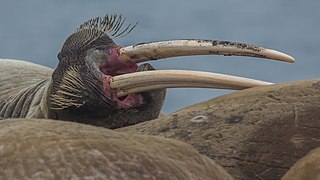
Bioturbation is defined as the reworking of soils and sediments by animals or plants. It includes burrowing, ingestion, and defecation of sediment grains. Bioturbating activities have a profound effect on the environment and are thought to be a primary driver of biodiversity. The formal study of bioturbation began in the 1800s by Charles Darwin experimenting in his garden. The disruption of aquatic sediments and terrestrial soils through bioturbating activities provides significant ecosystem services. These include the alteration of nutrients in aquatic sediment and overlying water, shelter to other species in the form of burrows in terrestrial and water ecosystems, and soil production on land.

Tanjung Piai is a cape in Pontian District, Johor, Malaysia. It is the southernmost point of Peninsular Malaysia and thus the most southern point of mainland Eurasia. The skyline of Singapore is visible across the Johor Strait from the point. It features seafood restaurants, perched on wooden jetties that are surrounded by a rugged and rarefied coastline of unspoiled mangrove forests.

Roebuck Bay is a bay on the coast of the Kimberley region of Western Australia. Its entrance is bounded in the north by the town of Broome, and in the south by Bush Point and Sandy Point. It is named after HMS Roebuck, the ship captained by William Dampier when he explored the coast of north-western Australia in 1699. The Broome Bird Observatory lies on the northern coast of the bay.

Mangrove forests, also called mangrove swamps, mangrove thickets or mangals, are productive wetlands that occur in coastal intertidal zones. Mangrove forests grow mainly at tropical and subtropical latitudes because mangroves cannot withstand freezing temperatures. There are about 80 different species of mangroves, all of which grow in areas with low-oxygen soil, where slow-moving waters allow fine sediments to accumulate.
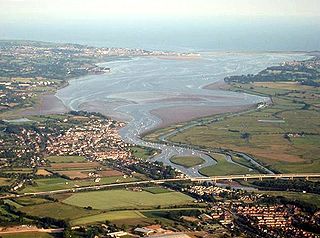
The Exe estuary is an estuary on the south coast of Devon, England.

The intertidal zone or foreshore is the area above water level at low tide and underwater at high tide: in other words, the part of the littoral zone within the tidal range. This area can include several types of habitats with various species of life, such as seastars, sea urchins, and many species of coral with regional differences in biodiversity. Sometimes it is referred to as the littoral zone or seashore, although those can be defined as a wider region.
The state of Johor in Malaysia is noted for its national parks and forest reserves which preserve virgin rainforests known for its biodiversity and endangered species of animals. Mangrove swamps and coral reefs are also protected within these parks.

Bahia Lomas is a bay in the eastern mouth of the Strait of Magellan in Southern Chile, on the north coast of the Isla Grande de Tierra del Fuego. The area is a large tidal plain, with a tidal variation up to 7 km. The wetlands of the bay are important sites for the red knot, the Hudsonian godwit and other shorebirds. The wetlands are a Ramsar site of international importance and an Important Bird Area.

Cerithidea decollata, common name the truncated mangrove snail, is a species of sea snail, a marine gastropod mollusc in the family Potamididae.
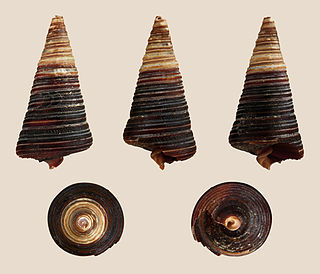
Telescopium telescopium, commonly known as the telescope snail, is a species of snail in the horn snail family Potamididae found in mangrove habitats in the Indo-Pacific. They are large snails that can grow up to 8 to 10 cm in length and are easily recognizable by their cone-shaped shell.

A marine habitat is a habitat that supports marine life. Marine life depends in some way on the saltwater that is in the sea. A habitat is an ecological or environmental area inhabited by one or more living species. The marine environment supports many kinds of these habitats.

Salt ponds are a natural feature of both temperate and tropical coastlines. These ponds form a vital buffer zone between terrestrial and marine ecosystems. Contaminants such as sediment, nitrates and phosphates are filtered out by salt ponds before they can reach the ocean. The depth, salinity and overall chemistry of these dynamic salt ponds fluctuate depending on temperature, rainfall, and anthropogenic influences such as nutrient runoff. The flora and fauna of tropical salt ponds differ markedly from those of temperate ponds. Mangrove trees are the dominant vegetation of tropical salt pond ecosystems, which also serve as vital feeding and breeding grounds for shore birds.
Listriolobus pelodes is a species of marine spoon worm. It is found in shallow seas in the North East Pacific off the coast of California. It lives in a burrow in soft sediments.
Hungry Bay Nature Reserve is a nature reserve on the east coast of Bermuda. It was established in 1986. It is considered the best example of coastal mangrove swamp on the island. It includes the Hungry Bay area and the largest mangrove coastal swamp in Bermuda. It is protected by a Tree preservation order (T.P.O.) and designated as an official Nature Reserve within the Parks system of Bermuda.
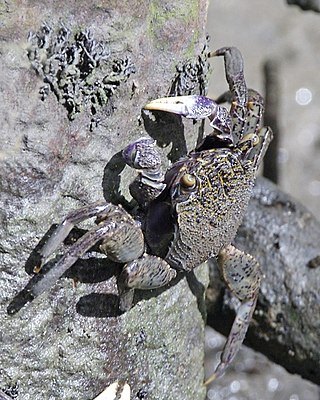
The violet vinegar crab is a swimming crab species in the genus Episesarma. Distributed all over marine and brackish waters of Indo-West Pacific regions. It is harvested by many local fishermen for rich proteinaceous food.

The Gulf of Panama mangroves (NT1414) is an ecoregion along the Pacific coast of Panama and Colombia. The mangroves experience seasonal flooding with high levels of sediment, and occasional extreme storms or very low rainfall due to El Niño effects. They are important as a breeding or nursery area for marine species. Areas of the mangroves have been recognized as Important Bird Areas and Ramsar wetlands. The ecoregion has been severely degraded by clearance of mangroves for agriculture, pasturage and shrimp farming, by urban pressure around Panama City, and by pollution related to the Panama Canal.

The Esmeraldas-Pacific Colombia mangroves (NT1409) is an ecoregion of mangrove forests along the Pacific coast of Colombia and Ecuador. It is threatened by human population growth, leading to over-exploitation for wood and clearance for farming and aquaculture.


















